Today i.e. August 29, 2014, Indians across the world celebrate Ganesh Chaturthi in honor of the birthday of Lord Ganesh (the son of Shiva and Parvati and a favorite God for millions of Hindus).
Does anyone now how old Ganesh is?
In several states of India, Ganesh Chaturthi is celebrated for several days and at the end of the festivities the idol of Ganesh is immersed in the river or sea.
Across the U.S., Ganesh is a prominent fixture at most Hindu Temples.
During our travels over the last several years, we’ve had the occasion to view Lord Ganesh in varied forms in the U.S.
In the festival spirit of Ganesh Chaturthi, SearchIndia.com presents the many faces of American Ganesh.
We start first with Ganesh at the Columbus (Ohio) Temple.
On the East Coast, at the Divya Dham Temple (below) we found this lovely Ganesh during a temple darshan with some Gujaratis.
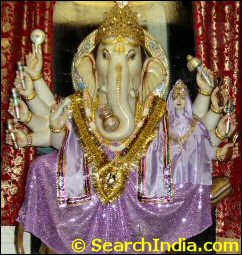
Ganesh @ Divya Dham
Elmhurst, NY
A few hundred miles south in Richmond, we found this entrancing Ganesh at the Hindu Temple in Richmond (Virginia). Notice Ganesh’s vehicle, the mouse, at the bottom.
About hundred miles north in Chantilly (Virginia), we found this Ganesh with large flapping ears at the Rajdhani Mandir (below).
In the temple town of Pittsburgh, there is a nice Ganesh in the company of his parents Shiv and Parvati at the Hindu-Jain temple.
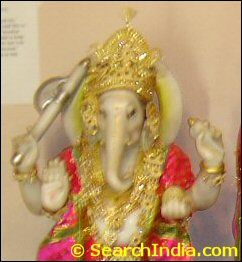
Ganesh @ Hindu Jain Temple
Pittsburgh, PA
On the West Coast too, there are plenty of Ganesh devotees (is there any place in the world without Ganesh devotees).
Right near the Mexico border in San Diego, we found this beautiful Ganesh at the Shri Mandir.
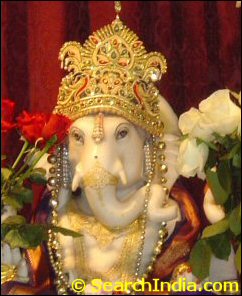
Ganesh @ San Diego (California)
Several hundreds miles north of San Diego, we found this charming Ganesh at the Siddhi Vinayak Temple in Sacramento a few years back.
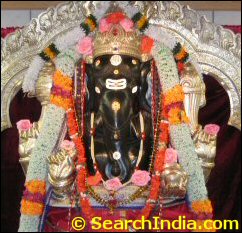
Ganesh @ Sacramento (California)
In Silicon Valley, home to a large Indian population, we found this Dollar Ganesh (below) in San Jose.
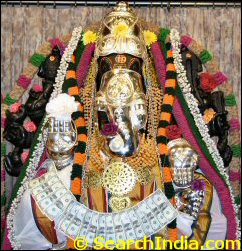
Ganesh
Lakshmi Ganapathi Temple
San Jose, CA
Wonder what the Americans would think if they knew that George Washington (on the $1 bills) was adorning Lord Ganesh at the Lakshmi Ganapathi Temple in San Jose, CA.
In the Malibu Hills (outside Los Angeles), we found this Ganesh (below in granite).
To see more pictures of your favorite American Hindu Gods, please click here.

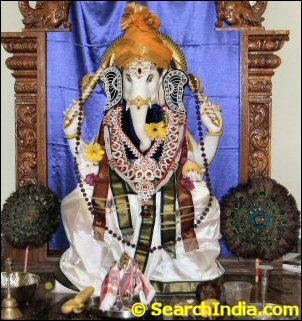
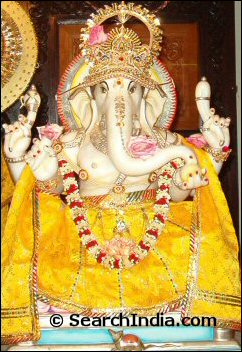
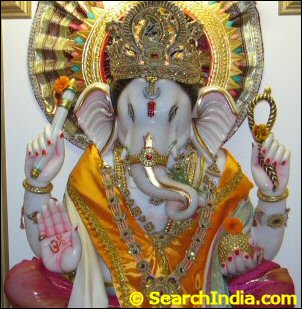
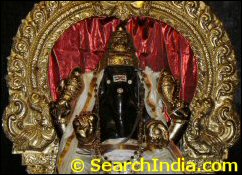
You write: Does anyone now how old Ganesh is?
Hindu timescale is defined in Yugas, see
http://en.wikipedia.org/wiki/Yuga
Our lifetime/ existence is infinitesimally insignificant as compared to the Millions of years that have gone by and that are yet to come.
We do not know in which Yuga Lord Ganesha came into existence.
Lord Ganesha is the most favoured God across the length and breadth of India and has Temples in every street corner in Tamil Nadu and has a presence in every Temple.
All poojas start with a pooja for Lord Ganesha. He is also called as “Muthal Kadavul” (the first God) in Tamil. When prayed before starting anything, he delivers us from all obstacles in all things we do.
Blessed will be those who pray to Lord Sri Vara Siddi Vinayaka. Wishing all the readers / surfers who pass by this blog a Happy Ganesha Chaturthi.
Why is this post on top? Did Ganesh Chathurthi come too soon this year?
SearchIndia.com Responds:
For the benefit of our
dear‘devout’ readers just in case they missed it earlier.I remember you putting out variuos Ganesha pictures last year also.
Very sweet.
Kozhukattai enga??
SearchIndia.com Responds:
Gosh! It must be a million years since I ate Kozhukattai!
I barely remember the taste now.
Ganpati bappa morya SI!!
Attendance potaachu
SearchIndia.com Responds:
To think that in this day and age, 950 million people believe that Ganesh/Ganapati exists somewhere in the sky and will bless them bountifully (birth of a son, IIT seat, victory in elections, promotion, transfer, marriage of daughter, H1B visa etc) if only they placate him with some Laddus and garlands.
Hindus/Indians must be the craziest of the world’s crazies!
It’s no different even in the U.S.
Some folks in Edison, New Jersey have installed a 14-ft idol of Ganesh.
As I’ve said often, you can take Indians out of India but not India out of Indians.
http://en.wikipedia.org/wiki/Ganesha
http://en.wikipedia.org/wiki/Ganesh_Chaturthi
Wow look at that post.
And I thought you were a modern Periyar!
Happy Ganesh Chaturthi SI!!
SearchIndia.com Responds:
To you too, Sweetie!
Although this 21st Century American Periyar has no idea what Happy Ganesh Chaturthi means.
BTW, I completely agree with Ram Gopal Varma’s tweets on Ganesh.
If Ganesh couldn’t protect himself from having his head cut off, how will he protect his devotees!
This RGV guy is a Sensible fellow (except when it comes to making movies).
https://twitter.com/RGVzoomin
All those Ganeshas are beautiful.
I’ve become much more tolerant of spirituality of late (chalk it up to experience with ‘real’ life than just college). It seems to have some innate valence for a substantial proportion of humanity. As long as people keep their beliefs to themselves (Or as in ancient India- castes keep their god(s) to themselves), I think the rest should let it be. In that spirit, here is a story from Kerala that some of you might find insightful:
It is believed that there was a famous mathematician and scholar by the name of Vararuchi, who, though being a Brahmin, by the force of fate came to marry a Pariah woman (long story). Upon realizing his mistake he proclaimed ex-communication for himself and together with his new wife went on pilgrimage. During their travels, they had 12 children all of whom were asked to be abandoned by Vararuchi which the wife complied with. Each of these orphan kids were found by a family of a different caste and they raised them as their own. The eldest one was raised by a Brahmin family as a Brahmin and came to be known as Mezhathol Agnihotri. Likewise, his younger siblings.
Out of them my favorite story is that of Akavoor Chathan who was brought up in a farming caste. He worked for a Namboothiri Brahmin that used to talk of something called Parabrahmam. Chathan being untrained in philosophy imagined it to be somewhat like the kuladevata (clan gods) that he was familiar with. Once out of curiosity and wanting to worship Parabrahmam since he has overheard some wonderful things about it Chathan asked the Namboothiri to tell him what it looks like. Amused by this stupid question, the Namboothiri told him it looks like one of the buffalo that he owns. Chathan took it seriously and started worshipping Parabrahmam as a buffalo. This went on for sometime until one day Parabrahmam appears exactly as that buffalo in front of Chatan. To his amazement it begins to talk to him and follow his commands. Chathan adds it to his normal herd as just another buffalo and maintains it- unaware that only he alone can see, hear and talk to it.
This goes on for a while. Once the Namboothiri and Chathan were walking with their buffaloes. There was a narrow passage up ahead and the Namboothiri with all of the buffaloes manage to pass it in a single file. But Chathan stayed back talking to the air as it seemed. The Namboothiri demanded an explanation upon which he was told that he was coaxing that one last buffalo to make the pass (it had big horns and needed to tilt its head to get through). What last buffalo? Have you gone nuts?
Chathan explains all about the talking, sophisticated philosophical (and apparently invisible) buffalo that follows him around and suggests the Namboothiri touch him so that may be he can see and hear it too. The Namboothiri agrees. Upon seeing the Namboothiri however, the erudite buffalo immediately began to run away. It disappears into a pit and is never found again.
At the place where it disappeared stands the Ochira Parabrahma Temple where there are no murtis to worship but rather just an empty square demarcated on four corners by a trident outside which we close our eyes and contemplate the Parabrahmam.
Some of us (each of a separate caste) believe we are direct descendants of the 12 children and celebrate the story as our history.
Even otherwise this story is widely taught to Hindu children in Kerala and personally it teaches me the following:
(1) We are what we are due to our training and upbringing which is determined by accident of birth. Every child in the story had the same biological parents but each turned out to have very different destinies. This also teaches me the universal brotherhood of man.
(2) Every one is a philosopher with their own conception of divine (or lack of it), their own methods to interact with it and their own understanding of the universe. This is what the buffalo represents. Crucially, you might never get another’s philosophy entirely (or experience his god) i.e his buffalo might always remain invisible to you though he can describe it to you. But it is important to understand that the buffalo ‘exists’ in some plane of reality as far as he is concerned.
(3) The buffalo is indeed Parabrahmam. It actually is. It is not a fake second-rate version. It is the real thing (as real it can get when talking of Parabrahmam anyway). Since it exists solely for Chathan, it is also inseparable from him.
In Kerala we don’t have brightly lit icons/murtis for our gods in temples like the ones shown above. Ours are made of pitch black stones and kept in barely lit sri kovils. We have to struggle to even make out the outline of the god especially since we are made to stand far away and never allowed too close.
All of this has a purpose. We are encouraged to see and worship Parabrahmam in temples whatever the nominal manifestation of it maybe. Such a tradition is especially strong in those temples whose rituals were set up by Shankara but nevertheless present to varying degrees in every one. Realizing ourselves as inseparable from Parabrahmam is also the purpose of Temples with mirrors installed instead of murtis as done by Narayana Guru. The same reason why Chinmayananda made it so that Tat tvam asi (That thou art) in big letters is the first thing millions of pilgrims read on entering the temple of Ayyappa at Sabarimala- a continuation of the tradition of centuries where each pilgrim is considered (and called as such) an Ayyappan. The ultimate objective of these subtle and overt tactics being to make you understand yourself as being inseparable and one with Parabrahmam- whatever the type of imaginary (for others) buffalo you talk and listen to for reaching there. Or in the words of Shankara- chidananda roopah sivoham sivoham.
So my heartfelt Ganesh Chathurthi to all Ganapataayas.
And may RGV’s buffalo protect him too.
SearchIndia.com Responds:
1. You write: I’ve become much more tolerant of spirituality of late…. It seems to have some innate valence for a substantial proportion of humanity. As long as people keep their beliefs to themselves ….
Tolerance is only for non-believers who recognize the notion of a God as the supreme myth.
For believers, the essence of most religions (particularly, Hinduism, Christianity and Islam) is intolerance toward those who do not profess or share the same faith. Notions of Parabrahmam or individual unique conceptions of the divine are fine and dandy in theory but their setting within the religious framework of Hindu ‘worship’ weakens them and makes it suspect in the eyes of others.
Because at the end of the day, make no mistake, religion is a ferocious battle for the hearts, souls and minds of people to worship the one ‘real’ God at the expense of all others. Although the battle-ground seems different, religion flourishes only in a Kurukshetra soil.
Since Religion is a zero-sum game, you have desperate, intolerant attempts to proselytize, Crusades, wars, notion of Infidels, countless modes of discrimination, funding of churches/mosques/Hindu temples in distant corners of the world to spread the faith and boost their numbers, demolishing temples, churches, mosques etc.
Without intolerance, there’s no growth of religion (except small fringe groups like Buddhists or Jains who don’t care). Early Christians suffered severe oppression and intolerance until the Roman Emperor Constantine lost his marbles and embraced Christianity in the 4th century AD. And then Christians became the most ruthless oppressors, far more brutal and intolerant than the Romans ever were. Ditto with Islam in its founding period.
White trash Christians in Europe and North America, Brown Christian rice-converts in India and Africa, BJP Hindu trash in Gujarat, Uttar Pradesh, Rajasthan and other parts of India are as demonic and intolerant as the most rabid Islamic fanatics.
Christians and Hindus couch their fanaticism in the veneer of civilization but scratch the surface and you see the dark colors of intolerance painted deep on their skin, same as that etched on a Muslim epidermis.
Intolerance Rules
Where religion marches, intolerance is just a step behind.
Irish Catholic bastards killed the Indian Hindu dentist Savita Halappanava by refusing to perform an abortion even though Savita’s life was in grave danger. Hindus turned a blind eye to the savage butchery of Muslims in Gujarat and revoted the butcher back to power, first in Gujarat and then gave him all of India. Muslims relentlessly chop off the heads of Christian, Jewish and Hindu ‘infidels.’ Christian nuts in Australia now want Chaplains in government schools. The Christian Right is a powerful influence on the U.S. Republican Party and a strong voice on matters like abortion, school prayers, preventing teaching of evolution in schools etc.
As long as one practices a religion, it’s folly to be tolerant of other religions unless you ask for extermination of your faith.
Intolerance is the other face of the religious coin.
Contrary to what you say, it’s idle fantasy to speak of “As long as people keep their beliefs to themselves….” Since Religion must beget intolerance for its survival and growth, people cannot and will not keep their faith or beliefs to themselves.
Religion – Always Public
There’s no such thing as Religion being a private affair.
If religion were a private affair, Swaminarayan sect would not be spending tens of millions of dollars building huge temples across India and America (last month, a massive Hindu temple opened in Robbinsville, New Jersey and when fully complete will be the biggest Hindu temple in the world). Saudi Wahabi Muslim zealots spend billions on their Madarasas that teach young boys contempt and hatred for other religions. And Ronald Reagan would not have destroyed the lives of countless Third World women by linking aid to abortion restrictions favored by Christian nuts.
Bottom line, religion is intolerant and always a public matter. Not a private affair between Shankaran Iyer/Rajubhai Patel and ‘Lord’ Ganesha.
2. As practised by the majority of people (Hindus, Christians and Muslims), Religion is a wild ‘me-too’ obsession, a thoughtless jump into the abyss without caring to look down and understand what lies in the gorge below.
After giving one reading to Nietzsche’s AntiChrist recently, I’m even more ill-disposed toward religion.
BTW, Nietzsche does have some interesting things to say about our Indian caste system, Vedas, Chandalas etc. But more on that later (after I give the book a second reading).
3. You write: We are what we are due to our training and upbringing which is determined by accident of birth.
My response will go off on a tangent now, far from religion.
We are what we are not merely because of socialization but more so because of genetic and biochemical makeup.
I’m a firm believer that a lot of major crimes are attributable to genetic makeup – stuff like impulse control, manic impulses, mood swings, mental capacity, propensity for violence or high tolerance for violence (extremely dangerous when present in ‘leaders’ like Stalin, Hitler, Narendra Modi, George W.Bush etc.
When the study of human medicine is far advanced (say 200 or 300 years from now), future generations will shake their heads in amazement that so many people in our times were imprisoned and executed for no faults of theirs.
Just as we are stunned that so many innocent medieval souls like Joan of Arc etc were burned at the stake on what we now consider ridiculous, primitive grounds future generations will look askance at our grotesque ‘medieval’ practices.
Although ‘religious mind-set’ is very similar across all religions, I consider the myriad schools of thoughts around which Hinduism revolves are far far far superior to those of any other religion (though a guy like Yogananda clearly explains how Bible is pure yoga) and I suspect many theories from Hindu school of thought were imported by other religions either covertly (Islam & christianity) or overtly (Buddhism).
Islam’s notion of Allah as shapeless entity is most probably a crude derivative of Hindu description of one of the major facets of Brahman as Nirakaara and Nirguna.
It is quite interesting that you mentioned genetic makeup that dictates the behavior of humans. That’s exactly the basis on which Hindu caste theory was founded and so called ‘Hinduism’ is the first and perhaps the only religion which daringly acknowledged the ‘genetic inequality’ among humans, although institutionalization of the same did unimaginable damage to the Hindu society.
That said, any religion as an institution purely falls in the psychological jurisdiction with its million rituals and prejudices like your insightful analysis reveals and there is nothing spiritual whatsoever about it…….
SearchIndia.com Responds:
I will pick up Yogananda’s book soon. I’ll start with his Autobiography of a Yogi.
SI, Concerning that reference to caste in araj’s comment, may I suggest- The Hindu Equilibrium: India c.1500 B.C.-2000 A.D. by Deepak Lal
SearchIndia.com Responds:
Deepak Lal is a respected academic.
I will get The Hindu Equilibrium: India c.1500 B.C.-2000 A.D today & start blogging about it Chapter-wise starting tonight/tomorrow.
What motivates my engagement with and accommodation of spirituality is my belief that we should deal with the world always keeping in mind the world as it is rather than what we think it should be. This means acknowledging the fact that spirituality is an undeniable part of the human psyche.
Just as we don’t deny hunger, thirst, love or lust as fundamental aspects of being human we shouldn’t (and cannot) deny spirituality either. I don’t think religion or ‘organized spirituality’ is the root of ALL evil. Hunger, lust and love of the organized kind- in the name of King or Republic for instance has accounted for very many evils in history- perhaps much more than spirituality. So I think the objective is to “channel” all of these impulses appropriately as to achieve the greatest good for the greatest number.
I do think atheists are the deviants among humans. This isn’t a value judgment. Asexuals or those who like very hot chillies are deviants too.
In a free society, there is bound to be an association between people who love the same sport team or political party. Likewise, organized spirituality (religion) too cannot be wished away. After the collapse of Soviet Union, the Russian Orthodox Church has regained its position and status in Russian society. Turkey is also regressing (if you will) to its religious nature. Even China -which has a long history of the state persecuting religions and is officially an atheist state- hasn’t been able to suppress the spirituality or religious inclinations of its people. Case in point, within a decade or so it will likely become the largest Christian nation in the world.
Now, though I wouldn’t push this line of argument too much I would note this passage from The Hindus: An Alternative History:
“This open-mindedness was supported by the tendency of Hindus to be more orthoprax than orthodox. That is, most Hindus have not cared about straight opinions (ortho-doxy) nearly so much as they care about straight behavior (ortho-praxy). Although there is a very wide variety of codes of action, each community has a pretty clear sense of what should and shouldn’t be done, and some things were Simply Not Done. People have been killed in India because they did or did not sacrifice animals, or had sex with the wrong women, or disregarded the Vedas, or even made use of the wrong sacred texts, but no one was impaled (the Hindu equivalent of burning at the stake) for saying that god was like this rather than like that. Each sect acknowledged the existence of gods other than their god(s), suitable for others to worship, though they might not care to worship them themselves. Hindus might therefore best be called polydox.”
There are always exceptions of course:
“Yet renouncers, certain monists, and some of the bhakti sects tended to be more orthodox than orthoprax, and those movements that challenge Brahmins, the Veda, and the values of class and caste are generally called heterodox, or even heretical (pashanda or pakhanda). 59 The Hindu concept of heresy was thus applied to some people within the Hindu fold, though more often to Buddhists and Jainas.”
All religions are the same at the cognitive level. “Theology”/Beliefs [orthodoxy] matters very little. Our actions [orthopraxy] alone matters. This is the insight that ancient Hindus stumbled upon and mostly emphasized and practiced. It is nice to have a theology [and preferably completely non-prescriptive as is the pagan way] that adheres to this [as with Kerala Hindus] but it isn’t really essential. Though it is kind of awesome that a Mallu figured it out explicitly.
Also, (1) Smartas (those who follow Shankara) have steadfastly refused to proselytize non-Hindus even in American temples. In Kerala, non-Hindus are barred from temples by force of legislation.
(2) The Dalai Lama is an atheist. Buddhists aren’t fringe- they number half a billion and were the earliest of missionary faiths.
(3) The Pope is convinced atheists are destined for heaven if they follow their conscience and also thinks religious proselytism is the “worst thing of all”. “Not proselytizing” made his list of “Secrets to happiness”.
(4) If Dawkins is a secular Christian then I think I am a secular Kerala Hindu.
Suggested reading: (1) http://blogs.discovermagazine.com/gnxp/2013/04/against-the-seriousness-of-theology/
(2) http://unqualified-reservations.blogspot.com/2007/10/how-dawkins-got-pwned-part-2.html
(3) http://www.thenewsminute.com/worlds/280
(4) http://www.charismanews.com/world/43997-atheist-richard-dawkins-i-am-a-secular-christian
I’ll hold my thoughts on the other stuff for the moment.
SearchIndia.com Responds:
1. I will read the posts in your five links and see what they have to say. And perhaps append to my response. Halfway through the Discover piece.
2. You write: What motivates my engagement with and accommodation of spirituality is my belief that we should deal with the world always keeping in mind the world as it is rather than what we think it should be.
There’s no question of accommodation with spirituality or any kind of religion. There’s only surrender to a religion or its eventual destruction/conquest.
I don’t suppose it’s a coincidence that even in the few so-called multi-ethnic societies (India, U.S, France, UK, Australia, Canada etc), one religion accounts for the overwhelming majority of the spiritually inclined.
As long as a religion remains a quiet minority, its members are safe (like Hindus in Pakistan). The moment members of a minority religion clamor for greater inclusion (like Muslims in India), the majority religion (Hinduism in India) will bare its fangs. Ditto with the backlash against Muslims in France and UK in recent years.
Religion or ‘organized spirituality’ may not be the root of ALL evil but as an association of people it’s at the root of much chaos, destruction and bloodshed.
If we can outlaw heroin, why not religion. We delude ourselves that things are eternal until we discover it is not!
We delude ourselves that things are eternal until we discover it is not!
3. Surprised to see the reference to Dalai Lama being labelled an atheist. After some quick research, I’m inclined to believe the reality is more complicated. Nor was I aware of Smartas not engaging in proselytization of non-Hindus in American temples.
A religious group can be numerically large and yet be on the fringe if they’re dispersed, live in countries hostile to religion (China) or its global influence is not significant vis-a-vis other religions.
4. I wonder if economic inequality in society correlates to greater religious tendencies.
I suspect a large Middle Class tends to reduce the power of religion, at least in some geographies. But the period when the Middle Class is growing is a moment of ferment, fertile to feverish incitement.
One of the striking aspects of the U.S. over the last six or seven decades is the growth of the Middle Class (alas, now receding). In the same period, religion lost much of its sheen. Church-attendance dwindled significantly and although a lot of people still called themselves Christian I doubt they really cared much about Jesus, Mary, Paul etc.
I don’t suppose Religion is a big affair in Singapore either!
Ultimately, even Religion may be just a matter of class.
“Surprised to see the reference to Dalai Lama being labelled an atheist. After some quick research, I’m inclined to believe the reality is more complicated.”
Buddhists, Jainas and Charvakas are Nirishwaravaadi (atheistic) and Nastika. All of them reject the concept of a supernatural God as myth and also the authority of Vedas. Among them, Buddhists reject the notion of a soul (individual or cosmic) as superstitious as well. Jainas in contrast maintain that there are individual souls for each living being (including plants and microbes). Charvakas are materialists who believe only the inferences from one of the six pramaanas- pratyaksha. Bauddhas and Jainas accept all the pramaanas except shabda (Veda). This is the reason why Bauddhas and Jainas believe in re-incarnation (an extension of karma-siddhanta using other pramaanas) unlike Charvakas who though agreeing with karma-siddhanta [actions have consequences] to a limited extent rejects re-incarnation.
The Nirishwaravaadi schools within the ambit of Astika (accepting the authority of Vedas) include- saankhya, vaisheshika and purva mimaamsa.
“Nor was I aware of Smartas not engaging in proselytization of non-Hindus in American temples.”
Here is the reference: “Among Hinduism’s four major denominations–Vaishnavism, Saivism, Shaktism and Smartism–only the Smarta lineage, represented by the various Shankaracharyas in India such as of Sringeri and Puri, does not accept converts. Smarta priests serving in American temples have consistently refused to perform the Namakarana Samskara, the name-giving ceremony [see next page] for non-Hindus by which they could enter the religion. But the spiritual leaders and priests of the remaining sects–representing perhaps 90 percent of Hindus–actively engage in conversion rites.”
http://www.hinduismtoday.com/modules/smartsection/item.php?itemid=4286
It is also important to make a note here with respect to “conversion”. Again, I wouldn’t push this too much but here is what The Hindu: An Alternative History says about proselytizing in ancient India:
“It is not always appropriate to refer to shifts in religious affiliation, between Buddhism, Jainism, and the Vaishnava and Shaiva bhakti sects, as “conversion”; it is generally better to reserve that term for interactions with religions that have jealous gods, like Islam and Christianity. For ordinary people in ancient South India, religious pluralism was more of a supermarket than a battlefield. Laypeople often gave alms to Buddhist monks or, later, prayed to Sufi saints and still visited Hindu temples. But there were some people who really “converted,” in the sense of reorienting their entire lives in line with a distinctive worldview and renouncing other competing worldviews; these were the relatively small numbers of monks, nuns, or saints, as well as the members of certain philosophical sects and—the case at hand—some of the more fanatical bhaktas.”
Suggested links: (1) http://koenraadelst.blogspot.com/2013/10/atheism-in-indian-philosophy.html
(2) http://kalchiron.blogspot.in/2010/09/aastikas-and-naastikas-system-of.html
SearchIndia.com Responds:
1. If the available evidence in favor of religion is sparse, it’s non-existent to support the notion of reincarnation.
2. The problem of expressions like “atheism” etc is that definitions themselves are ethnocentric seen differently when viewed through the prism of different cultures (and people). This makes universal definitions for a lot of concepts an impossibility.
With most non-Scientific phenomenon a lot of the same processes can be viewed and interpreted differently throwing the concept of “knowledge” itself into disarray.
The reason I bring this up is with regard to Dalai Lama and Atheism that you brought up. When I researched the issue, I found Dalai Lama’s supporters (and presumably the Dalai Lama himself) view atheism in a different sense.
3. Based on my observation, there are too many Hindu temples to support the Hindu population in the U.S. I’m inclined to believe that to keep the Hindu temples going our priests (be they Smartas or Madhwas) will not deny any service to anyone (some like the idiot Commander Selvam of Atlanta was even willing to allow Meat and Liquor). Plus, over the last few years the growth of Swaminarayan temples (a honeypot for Gujaratis) means the other Hindu temples are at a huge disadvantage in funding.
4. Regarding conversions, that’s possibly the worst manifestation of religion that strikingly highlights the notion of intolerance at the heart of most faiths and makes religion a public affair not a private relationship between Man and “God.”
But the religious pluralism you mention embraces even Christianity in India. It’s evident in pictures in churches of Christ as Buddha etc and the use of names like Harish Paul, Satish Daniel etc.
But Islam is more of a closed wall.
Hindus still visit Dargas and Sufi shrines (including several of our Hindu Bollywood stars). Unlikely you’ll see Muslims visiting Sringeri Mutt or Varanasi’s Vishwanath temple.
I don’t think the term “atheistic religions” (Buddhism, Jainism, Marxism-diamat, Dawkin’s “Einsteinian Religion” or “non-theistic Christianity”) is an oxymoron.
Atheism is, “in a broad sense, the rejection of belief in the existence of deities.[1][2] In a narrower sense, atheism is specifically the position that there are no deities.[3][4][5] Most inclusively, atheism is the absence of belief that any deities exist.[4][5][6][7] Atheism is contrasted with theism,[8][9] which in its most general form is the belief that at least one deity exists.[9][10]”.
Atheism has been historically a part of the spiritual landscape in India ( https://en.wikipedia.org/wiki/Atheism#Atheism_within_religions ) as a valid course of inquiry. Some prefer “metaphysics”, “moral philosophy” etc over “atheistic religions”.
I’ll leave you with this article on how saankhya-bauddha debates informed those of Schrodinger and Heisenberg: http://www.upscale.utoronto.ca/GeneralInterest/Harrison/DevelQM/DevelQM.html
SearchIndia.com Responds:
1. Atheistic religion is a hard concept to grasp, paticularly within the Hindu context.
2. The upscale.utoronto link piece is interesting.
3. I have started reading your recommendation Hindu Equilibrium…will split it into a few sections and write about it soon. This book appears at first glance as a guide to understanding Indian poverty within the framework of caste system. Let’s see where it takes us.
4. While following one of your links, I stumbled another link containing an interesting study:
http://www.wingia.com/web/files/news/14/file/14.pdf
Religiosity is increasing in Pakistan (from 2005-2012), perhaps a good hypothesis to explain increase in tensions between Pakistan and India over the last 10 years.
“Atheistic religion is a hard concept to grasp, paticularly within the Hindu context.”
If you want a more authoritative source other than blog posts I suggest: Indian Philosophy- A Very Short Introduction by Sue Hamilton*
If it helps to clarify: Only the top orders of Buddhism and Jainism are likely to be atheist. The same with Hindu atheist schools. The rest are just like those of any other religion. This is why common Sri Lankan Buddhists, Hindus and Muslims have the same understanding of the supernatural (first link).
I have suspicions that there are substantial numbers of atheists among the clergy in Christianity and Islam too. Just that they don’t come out as atheist/agnostic like a Vedantin or the Dalai Lama.
On the other side of the mirror are the Marxist leaders in Kerala who cover their heads and secretly visit Temple/Church/Mosque.
*Excludes the super-cool Jainas and Carvakas though.
SearchIndia.com Responds:
Covert religious practice is not restricted to Marxists.
Some DMK and DK leaders and followers too were covert and occasionally overt practising Hindus.
Back in Tamil Nadu, I was aware of one DK member who resorted to the extreme “rolling” nonsense at a temple. Not sure if this “rolling” nonsense still exists.
MGR’s favorite Hindu religious destination Thai Mookambika temple in Kollur.
Autobiography of a Yogi is available online for free http://www.crystalclarity.com/yogananda/index.php …. But you would be very disappointed if you are looking for a vigorous intellectual stimulation or a groundbreaking metaphysical perspective. The book is more significant for the amazing supernatural events that have transpired in Yogananda’s life than for insight or intelligence. In fact, Yogananda somehow comes across as a conformist and often incites sense of deja vu despite his extraordinary spiritual experiences he brings forth in the book. After reading Autobiography of a Yogi and thus encountering Yogananda’s moderate intellect, I couldn’t help but wonder whether meeting with a higher intelligence in one’s life is just sheer accident or our earthly acumen may not necessarily reflect the vibrancy of our soul……
If you are indeed looking for a thorough metaphysical shakeup (or titillation), I would recommend you to read Jiddu Krishnamurti. You may start with Pupul Jayakar’s J. Krishnamurti: A Biography. You may find tonnes of stimulus there.
I leave you with a sample here –
“One of the most curious things in the structure of our psyche is that we all want to be told because we are the result of the propaganda of ten thousand years. We want to have our thinking confirmed and corroborated by another, whereas to ask a question is to ask it of yourself. What I say has very little value. You will forget it the moment you shut this book, or you will remember and repeat certain phrases, or you will compare what you have read here with some other book- but you will not face your own life. And that is all that matters- your life, yourself, your pettiness, your shallowness, your brutality, your violence, your greed, your ambition, your daily agony and endless sorrow- that is what you have to understand and nobody on earth or in heaven is going to save you from it but yourself – Freedom from the Known ”
SearchIndia.com Responds:
I will read both. My library should have Jiddu’s biography.
Right now I’m half-way through the delightful Panic in a Suitcase (Yelena Akhtiorskaya) and started on Deepak Lal’s Hindu Equilibrium.
Since SI is being extremely gracious….
I find books on spirituality written from a rationalist or scientific perspective to be more worth my time. The Tao of Physics by Fritjof Capra was my introduction to this genre and is among my favorites.
https://en.wikipedia.org/wiki/The_Tao_of_Physics
There is also a book that’ll soon be available written by Sam Harris who is one of the founders of the “New Atheist” Movement ( https://en.wikipedia.org/wiki/New_Atheism ). The first chapter is available online and looks interesting. Some bits caught my eye:
And:
He seems to style himself as a Hindu Guru if I may be bold :-p. Narayana Guru for instance did much of the same. He was similarly influenced by Buddhism and Advaita Vedanta (with some Tamil Shaivism thrown in) and reformed them by removing outdated restrictions etc.
http://www.samharris.org/blog/item/chapter-one